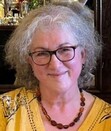In Conversation with Historical Fantasy Author R Marsden
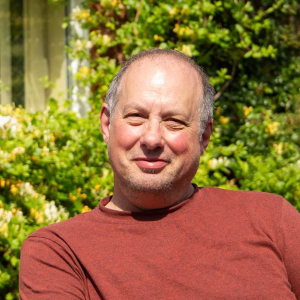 Meet Rory Marsden, who writes historical fantasy novels as R Marsden
Meet Rory Marsden, who writes historical fantasy novels as R MarsdenAs regular readers of my blog will know, I end each month in conversation with an author friend whose work and writing life I think will interest my readers too – even though they may be writing in a completely different genre to my cosy mysteries and other ficiton. To round off November, I’m delighted to welcome my friend and former student Rory Marsden, who writes as R Marsden, and shares news of his books and his writing life at his website www.talesofcastlerory.co.uk.
I first met Rory through the Simply Self Publish course that I teach online for Jericho Writers. A condition for enrollment on the course is that students have at least one publish-ready novel to which they can apply what they learn on my course. Rory immediately impressed me by having not only several novels ready to go, but also a masterplan for a series of 36!
I don’t often read medieval historical fantasy, and I didn’t really have anything in my recent reading to compare it to, so I asked my friend Helen Hollick, a highly successful and experienced author of historical fantasy and historical fiction, what she thought of it. Here’s an extract from her enthusiastic endorsement of the first in series, The Box of Death:
The first in the series
R Marsden’s imagination is immense, with detail of everyday life, weaponry, battles and such included to create a plausible other world where fiction is so entirely suspended that you forget this isn’t a real place, real people or real events.
For reasons that will become clear in our conversation below, I’ve become hooked on Rory’s, which starts with The Box of Death. (I love his titles too – they always intrigue me.) When I started writing my Sophie Sayers cosy mysteries, I had a grand plan of writing a seven-book series, for which I chose the titles before I started writing. So although we’re writing in different genres, I detected a kindred spirit.
Rory was quick to start publishing his books, and I’ve been following them ever since, as rattling good adventure stories with flawed yet likeable characters, plenty of twists and turns, and fascinating depiction of medieval life which never feels like a history lesson.
Debbie: Before we go any further, Rory, please tell us more about your background before you started publishing your books
Rory: I grew up in a London suburb, but I’m a country boy at heart, so my partner and I moved to Norfolk, where I’d spent many idyllic family holidays as a child. Here, we brought up two wonderful children and a border collie, sailing on the rivers and broads of this amazing part of England. My children had a true Swallows-and-Amazons childhood! They had music as well, since I’m both a musician and a scientist.
At school, I loved English, history, music, French, German, biology and chemistry. I wasn’t much good at sport, and I was hopeless at art! After school, I did a degree in biochemistry at University College, London and was engaged for a while in some cutting-edge research in the field of genetics.
For personal reasons, I left my research work and trained as a teacher. For a long time I was a class teacher in my village primary school, which meant everyone in the village knew my name! After many years, I left classroom work to teach piano and electronic keyboard in my home.
I love being self-employed, and this feeling of being my own boss is probably the reason I chose to publish my books myself rather than seek a traditional publishing deal.
I am the organist in my parish church, and this means a lot to me. I still teach piano and keyboard to my lovely pupils, both children and adults, and I enjoy being involved in medieval events around the country. I’ve taught myself to play the gittern (an early form of guitar) and I have a replica fourteenth-century recorder, which is also great fun to play. When I perform in medieval fayres, I attach jingles to my ankles, I have a drum I can tap with my foot and I play recorder or gittern at the same time! Takes a bit of practice!
Debbie: Gosh, I never knew you were a scientist too, Rory – you’re truly multi-talented! Now, can you please share a brief description of the concept behind your series.
Rory: I wrote The Box of Death around the title. The title just came into my head, and I wrote a book that incorporated it. But before that, I knew I needed to write a book set in the Middle Ages, and that was because of my AirBnB room! After much deliberation, I’d decided to call my guest accommodation “The Buttery”, but it was only after that decision was made that I found out what a “buttery” actually was – a service room in a medieval castle. So I remodelled my house on such a castle. Obviously. And that castle needed a context, a story behind it. That was the inspiration for the book, while the title, as I said, just happened along.
Having finished The Box of Death, I kind of wanted to know what happened next. I left Lord Rory pretty despondent in his lonely library, wondering if the last fifteen years of his life had been the triumph he’d always assumed. Deciding that no, actually he’d made many bad mistakes. The book closes with a air of gloom, and I didn’t want to leave it like that. I’d also given Rory a younger brother, and, simply to account for his absence from the castle, I’d made him a mercenary soldier, fighting battles for other people somewhere in Europe. So, in Book Two, The Soldier of Fortune, I explored Nicholas a lot more, and I found him to be an interesting character in his own right.
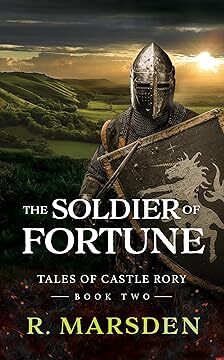 Book 2
Book 2And so the series grew organically, with no plan (at least at first) and no particular concept (at least at first). Book Three, The Man in the Moon, also grew from the title. I just liked the idea of writing a book with that title!
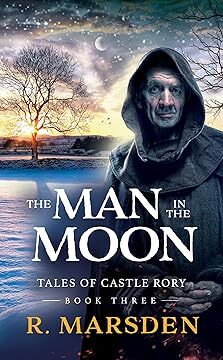 Book 3
Book 3The series concept is a lot clearer now, and, in fact, I know exactly where it’s going. But it’s taken six years to find out!
Debbie: I mentioned earlier that b efore you published the first book, you had a grand plan that the series would run to 36 books. Why 36?
Rory: This is a great question, because it follows directly from my previous answer! Once I knew the series concept, I knew how it was going to end. The series, Tales of Castle Rory, is a set of secret journals which Lord Rory of Hambrig writes. In each Tale he notes down his hope that one day, “maybe a long time from now”, someone will read his journal and will understand “how and why we did what we did”.
I love this idea – that someone is writing a diary for future generations to understand a time before their own.
Debbie: As a reader, I think it works really well – and it adds further excitement to his adventures that he seems to be recording them as they happen.
Rory: This hope, or dream as he calls it, is stated in every one of the Tales, each of which is approximately a year of Lord Rory’s life, although he’s already 33 when he begins writing. So I had to work out the year of his death, since that would clearly mark the end of the Tales. Once I knew that, I had the exact number of books needed to complete the series.
Which turned out not to be true! Sometimes a Tale spans more than a year, since the Epilogue may take place a year or so after the end of the main narrative. So I have hazarded 36 books, but until I get close to the end of Lord Rory’s life, I won’t know exactly.
I would like to add that, although so far I’ve written the first seven books out of a possible 36(!), I have also written the final book. This book does not chronicle Lord Rory’s death, as you might expect, nor is it his final Tale with the last journal entry an unfinished sentence with ink desperately trailing down the page. Instead, it’s a novel set in the year 2022, and it’s called The End of Time. Here, then, is Lord Rory’s dream finally fulfilled.
Debbie: Wow! I’ll look forward to finding out what that’s all about! So, must the books be read in order of publication or do they work as standalone novels too?
Rory: Of course you can start anywhere, but it makes a lot more sense if you read from the beginning. I remember picking up one of C J Sansom’s Shardlake series and loving it. I found out it was Book Three, so I went back to the beginning and read the series in order. But the Shardlake books don’t rely on many previous characters reappearing in each book, and my Tales of Castle Rory assume you know not only the characters, but their relationships with each other, from previous books. So start at the start!
Debbie: We should mention there’s also a free prequel available to anyone who joins your mailing list, set during the Crusades. For our readers’ benefit, please explain how the prequel relates to the rest of the series.
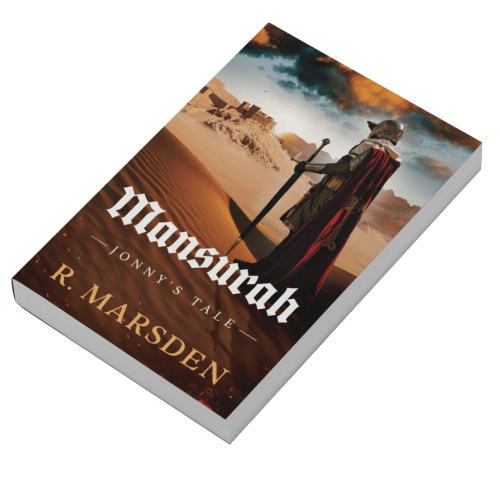 This is the free prequel you can download when you join his Household News mailing list via his website
This is the free prequel you can download when you join his Household News mailing list via his websiteRory: In his journals, Lord Rory often refers to his time on the Seventh Crusade. This period of his life, approximately five years, forged him as a man, brought him friendship with Jonny and allowed him to grieve for Kathryn.
It gave him skills and values that he draws on throughout his life.
After I’d written several of the main books, I knew I needed to find out more about Rory’s adventures on Crusade, and this was roughly the time I found out about “reader magnets” – free books for subscribers to an author’s mailing list. I set up my newsletter, which I call “The Household News” (I picture it as a parchment scroll, pinned to the door of the great hall by Sir Patrick, the castle steward, informing the household of everything that’s happening), and I decided that my “reader magnet” would be the story of Rory as a Crusader.
And then I made the decision to tell it from Jonny’s point of view. I felt it would be good for me, as an author, to explore my main protagonist from the outside. Because the main books are Rory’s journal, they’re obviously written in the first person, and everything is told as he sees it. This shorter book (it’s a novella) gave me the chance to use Jonny’s voice instead. I think it reads very differently from the Rory-point-of-view books.
I assumed that anyone reading the prequel, called Mansurah: Jonny’s Tale had already read The Box of Death. So they would know who Rory and Jonny were, and would be able to put the Crusader story in context as a prequel. But it is also a standalone novella, assuming no previous engagement with the characters.
Debbie: I actually started by reading the prequel, which really whetted my appetite for the first book in the series proper, and the transition from novella to novel, and the change of perspective, worked very well for me. Now, 36 books equates to a lot of adventures! How will you make adventure different and distinctive, and how much will be fantasy and how much historical realism?
Rory: My books are character-driven, so it’s the development of Lord Rory, Jonny, Kit, Patrick and the others that makes each Tale different. Rory’s difficulties with women, the breakdown of his friendship with Jonny, his admiration for Kit, his dependence on Patrick and his fear of failure all make each adventure different, as these problems or tendencies increase and decrease according to events.
Before starting a new book, I research the historical events during the year in which the book is to be set.
These, if at all possible, are then incorporated into the story and form the backdrop. So The King’s Ransom, set in 1265-66, has the formation of the Hanseatic League as its backdrop. Although the main story is about Rory’s marriage to the daughter of the King of Smander, this very connection has been set up by the King of Mallrovia, who is desperate for Hambrig to be accepted into the new trading league. Everything, therefore, revolves around this.
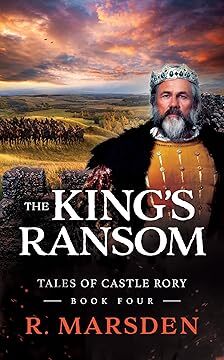 Fourth book
Fourth bookSimilarly The Soldier of Fortune takes place in 1264, the year of the Battle of Lewes during the Second Barons’ War in England. Rory and his companions end up taking part in this battle and being drawn into the ideas of democracy, parliament and elected representatives.
Fantasy creeps into each book (because I love it!), but it’s more obvious in some than in others.
It’s almost always based in fact, which seems a contradiction in terms, but Jabir’s alchemical laboratory is based on real discoveries, the use of hallucinogenic drugs (especially in the Middle East) is well documented from this time, and the binding of magic to religion was an accepted construct of the time.
The only “true” fantasy, i.e. not based on primary source evidence, is Kit’s knowledge of the future. This allows me to have more flexibility in the story arc and, I hope, to tantalise the reader.
Debbie: Yes, those little hints from Kit work very well! So, as you introduce new characters and settings in each story, how do you keep track of them along the way?
Rory: I have two spreadsheets, one called TOCR People, the other TOCR places (TOCR = Tales of Castle Rory). The People list gives me names, dates of birth/death, relationships, and if they are historical or my own characters. The Places spreadsheet details all places, both geographical and fictitious, and I have also calculated distances between them and how long it would take to walk, ride, or travel by horse and cart.
Debbie: Gosh, I wish I was that organised with my characters and settings! I need to learn to love spreadsheets!
Rory: Also, this year, I discovered AI! This has been fantastic for my characters.
I use AI to show me what each person looks like at different stages of their life, by telling it the main features, social status and setting.
I love having these pictures to work with, they really help me “see” my characters.
I’m also indebted to my illustrator, Ian R. Ward, who drew the map of Mallrovia and the plan of the castle. These are included at the start of each book, and they’re also on my website. I’d be pretty lost without them!
Debbie: Yes, the illustrations are really atmospheric as well as helpful. Now for the question that readers have probably been wondering since the start of our chat! Your protagonist shares your name. To what extent are his adventures your wish fulfilment?
Rory: I love this question, and thank you for asking it! My books were not written for publication. Not when I wrote the first two or three, anyway.
They were written for my family, and most of all for me to share with my mum, who was also an author.
She had helped me choose my Airbnb name (“The Buttery”), and she encouraged my writing and loved my stories. Her name was Joan, and, in the Tales, Joan is Rory’s best friend. Rory always says that Jonny is his best friend, but in reality it’s Joan. The books, therefore, were not for others to read, in the same way that Lord Rory doesn’t want his journals read by his contemporaries.
My mum died last year, and my books are published in honour of her. She wanted me to publish them, but I always said they were just “for us”. Now there’s no longer an “us”, and I have done what she always wanted.
Debbie: That’s so lovely, Rory. I bet she’d be really pleased and proud. So if Lady Joan is a tribute to your mum, is Lord Rory really your alter ego?
Rory: Yes, in many ways, Lord Rory is my alter ego. But what is less obvious is that Nicholas and Tamsin (Lord Rory’s brother and sister) are also my alter egos.
My writing is not an exercise in self-exploration, although it may sound like it from the above, and in fact I didn’t even realise much of this myself until I was part way through Book Three.
Surely, though, all authors put themselves into their books? Not overtly, or explicitly, but to some extent at least? Clearly, it is more overt in my books, since my hero has my own name, but, as I’ve said, that’s purely because when I began the series it was never going to be seen by anyone other than my mum. And, because of the way it grew, because of this idea I had to honour her in this way, I had no desire to change my characters’ names even after making my decision to publish. And this is why my author name is R. Marsden.
Debbie: I completely agree, Rory! Whether or not we do it consciously and intentionally, we can’t help but draw on our own experiences and characters. One of my longest-standing friends, whom I’ve known since I was 11, said to me once, “Sophie Sayers, she’s just you, really, isn’t she?” Although I’m old enough to be Sophie Sayers mum, and, at a stretch, even her grandmother, and she’s quite a dippy characters in some ways, I decided to take that as a compliment!
But at least with Sophie Sayers I’m writing a contemporary story, set in a village inspired by the one I’ve lived in for most of my adult life, so I don’t have to do much research. In fact, villagers approach me with story ideas now – at bell ringing practice, my fellow bell ringers keep telling me new and different ways to murder someone with a bell! Whereas your books have a sound foundation of historical fact. To write such a long series requires a huge amount of factual historical knowledge. How do you research your books?
Rory: I do a great deal of research, both before I begin writing a book and during the course of creating the first draft. I love the British Library’s collection of digitised manuscripts and have made great use of these as primary sources. I also have a large collection of books, and have made particular use of the ones by Joseph and Frances Gies, a lovely collection of books on medieval life. I have books on swords, daggers and shields, books on heraldry and many books on medieval combat and warfare. I have drawn on these extensively, as well as many articles on the internet.
But it’s the primary sources I always locate first. It takes a great deal of time, but it’s so enjoyable, and so essential, I don’t mind doing it at all.
Debbie: Tales of Castle Rory are set largely in territory is now East Anglia. How much of East Anglia’s history, geography and culture are embedded in your books?
Rory: My kingdom of Mallrovia equates to the county of Norfolk (where I live), and the principality to the south, Westador, equates to the county of Suffolk. The history, geography and culture of Mallrovia and Westador bear no resemblance to those of Norfolk and Suffolk, with the exception of one aspect only: I have transcribed the Norfolk accent to be the Hambrig dialect in my books. I like to think Norfolk people would recognise this! But this is my only reference to these genuine counties; in all other respects there is no equivalence.
Debbie: Now for a more general question. Who are your favourite authors in your genre and why?
Rory: I have always struggled to know which genre I write in. On the face of it, it’s medieval fantasy, but in most people’s minds this means dragons, wizards, strange beasts or alternative universes. My books have none of these tropes.
My fantasy is different, and my books are grounded in real historical events, and also – apart from my fictitious countries of Mallrovia, Westador and Smander – real geographical places.
However, I have just read one of Robin Hobb’s books, and her genre is pretty close to mine – what I believe is termed “genre-adjacent”. In historical fiction, I love reading Ken Follett, C.J. Sansom and Anne O’Brien.
Debbie: Here’s another way of defining your genre: how should readers feel after reading one of Lord Rory’s adventures?
Rory: My hope is that readers feel empathy with the characters.
I’ve tried to make them three-dimensional, so nobody is utterly heroic and nobody is unrelentingly evil.
I would love it if readers sympathise with the dilemmas Lord Rory wrestles with, especially his own demons. As I’ve said already, each “adventure” is really a vehicle for character expression and development. So hopefully it’s the people who stay in the mind, rather than all the shenanigans!
Debbie: What inspired you to write about this particular era and this particular region?
Rory: Well, as you know it all came from naming my airbnb room “The Buttery”. However, originally, I was going to have the action set a hundred years later, so fourteenth rather than thirteenth century. But I’d set my heart on the hero having been a Knight-Crusader, so when I found the Crusades were all over by 1272, I had to move the action back a hundred years.
As for the region – this was such a personal project, it needed to be based where I am. Making Norfolk into a sovereign state was a lot of fun and gave me a huge amount of leeway to have places where I wanted them and create hills, rivers, uplands and lowlands wherever I chose. Once Ian Ward had drawn the map, it all became very real, and I could picture the travellers as they move from place to place. The place names are my own invention, and there’s a good reason for all of them, but you’ll have to read the final book to know what that is!
Debbie: Gosh, that’s tantalising! Another practical question now: you’ve come to writing fiction at a relatively mature age. When did you first conjure up Lord Rory’s world?
Rory: The world built itself, bit by bit. The castle was always there, and I placed it high on a hill with a treacherous river at the bottom. I began writing in December 2018, and it’s been an organic process, growing and developing slowly over the last six years. I had no idea when I started where it was all leading. Now it’s exciting to wonder what direction it will take as I move inexorably towards The End of Time.
Debbie: Even for someone as industrious and prolific as you, writing 36 books is a tall order. Do you have any other writing ambitions?
Rory: No. It will be enough for me to complete this series, and I’m so immersed in the World of Hambrig, it would be hard to emerge from it and enter some new sphere. Tales of Castle Rory isn’t my first writing project though.
Years ago I wrote a trilogy about a teenage boy encountering a crime scene. It was told from the point of view of his dog. I enjoyed writing it at the time, but I haven’t read it since. Before that, when my children were young, I was always writing stories for them, and composing songs as well.I’ve been a creative writer and composer all my life.
Debbie: Rory, thank you so much for sharing these insights into your fabulous series today. I’ll pop useful links below for anyone who’d like to try your stories for themselves, whether the free novella available when they sign up for your newsletter, or the five books published so far. Now I’m off to catch up with books 4 and 5 – The King’s Ransom and Paradise Garden, in hope of catching up with you before your publish book 6!
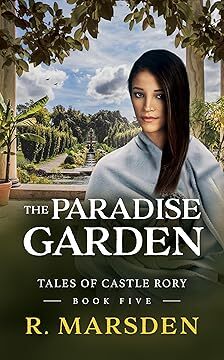 Book 5FOR MORE INFORMATION ABOUT R MARSDEN AND HIS HISTORICAL FANTASY BOOKS
Book 5FOR MORE INFORMATION ABOUT R MARSDEN AND HIS HISTORICAL FANTASY BOOKS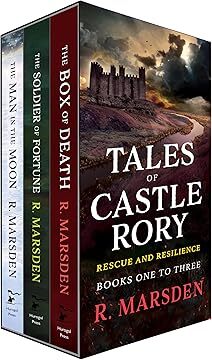 Tales of Castle Rory website: www.talesofcastlerory.co.uk
Tales of Castle Rory website: www.talesofcastlerory.co.uk
(where you can download the free prequel novella, Mansurah: Jonny’s Tale, when you sign up for Rory’s Household News newsletter)
Order the novels as paperback and ebook for Kindle via Amazon worldwide here.
(If you subscribe to Kindle Unlimited, you can read all his novels at no extra cost as part of your monthly subscription.)
Another good way to catch up with Rory’s books is to download the first three novels as a box set of ebooks for Kindle.

